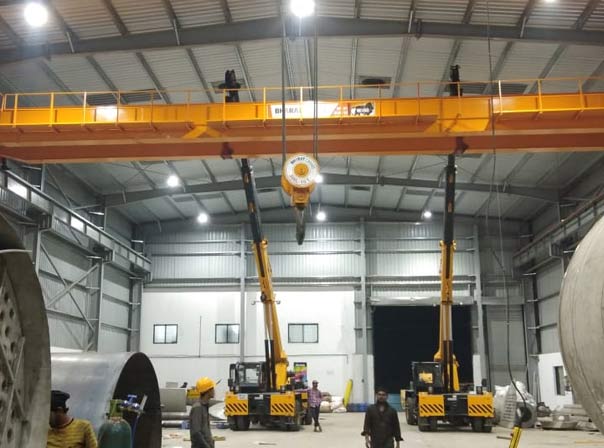Key Guidelines for Choosing the Perfect EOT Crane
Choosing the right Electric Overhead Traveling (EOT) crane is critical to enhancing efficiency and productivity in industrial operations. With various types and configurations available, selecting the ideal EOT crane can be a complex task. Whether you're a manufacturer, warehouse manager, or in construction, understanding key guidelines ensures you make an informed decision. In this blog, we’ll explore the fundamental aspects that guide you toward choosing the perfect EOT crane for your specific needs.
1. Understanding Load Requirements
The first and foremost consideration when choosing an EOT crane is the load capacity it needs to handle. Each crane has a maximum load limit, and exceeding this can result in mechanical failures or safety hazards. Evaluate the type of materials, products, or machinery your operations require to lift and transport. You must select a crane that not only meets your current load demands but also accommodates potential future needs.
Key Tip: Always aim for a crane with a slightly higher load capacity than your heaviest load to ensure optimal performance and longevity.
2. Determine the Span of the Crane
The span refers to the distance between the crane's runway rails, essentially the width it needs to cover. Depending on the size of your workspace or factory, it’s essential to choose an EOT crane with the right span. If your crane has an insufficient span, it may limit movement and efficiency. On the other hand, too large of a span can lead to unnecessary expenses and structural challenges.
Key Tip: Accurately measure the width of your workspace and discuss with your crane supplier to determine the optimal span for your operations.
3. Type of EOT Crane: Single or Double Girder
The type of EOT crane you choose, whether single girder or double girder, largely depends on your operational requirements.
Single Girder EOT Cranes are suitable for moderate loads and are cost-effective, making them ideal for small to medium industrial applications.
Double Girder EOT Cranes can handle heavier loads, offering greater lifting height and improved stability. They are ideal for large-scale manufacturing facilities or heavy industrial tasks.
Key Tip: Evaluate the load requirements and operational scale before choosing between single or double girder configurations.
4. Consider Lift Height and Speed
The lifting height refers to how high the crane needs to raise the load. This is crucial, especially if you are working in tall facilities or dealing with high-stacking requirements. Additionally, the lifting speed impacts how efficiently tasks are completed. Faster speeds may be required for high-volume operations, while slower speeds are ideal for delicate or precise tasks.
Key Tip: Balance lifting speed with safety requirements. Opt for variable speed options to give your operators greater control.
5. Assess the Duty Cycle
The duty cycle represents how often and how intensely the crane will be used. Cranes are classified based on their usage frequency, such as light duty, moderate duty, and heavy duty. Choosing a crane with the appropriate duty cycle ensures longer equipment life and fewer breakdowns.
Light-duty cranes are suited for occasional use.
Medium-duty cranes handle moderate workloads.
Heavy-duty cranes are built for continuous use in demanding environments.
Key Tip: Estimate your crane’s workload and operational hours to select a crane that fits the required duty cycle.
6. Workspace Layout and Crane Mobility
The layout of your facility plays a significant role in selecting an EOT crane. Assess whether your crane needs to move in multiple directions and cover an extensive area, or if its movement will be restricted to specific zones. Additionally, ensure your workspace can support the crane’s structural requirements without limiting other operations or equipment.
Key Tip: For complex or irregular layouts, consider installing auxiliary components such as jib cranes or monorail systems to complement the EOT crane’s operations.
7. Ease of Maintenance and Support
Crane maintenance is critical to ensuring long-term performance and safety. Selecting a crane from a reputable manufacturer that offers after-sales support, spare parts availability, and maintenance services can save you significant downtime and costs in the future.
Key Tip: Opt for manufacturers who provide comprehensive maintenance services and have an established network of support technicians.
8. Safety Features
Safety is non-negotiable when choosing an EOT crane. Modern cranes come with an array of safety features such as overload protection, emergency stop buttons, anti-collision devices, and limit switches. These ensure not only the safety of the operator but also the integrity of the load and surrounding equipment.
Key Tip: Always prioritize cranes equipped with advanced safety features, even if they come at a higher price.
9. Energy Efficiency
In today’s environmentally conscious world, energy efficiency is a growing concern for industries. Many EOT cranes now come with energy-saving features such as regenerative braking, variable frequency drives, and efficient motors. These features not only reduce energy consumption but also lower operational costs over time.
Key Tip: Look for cranes with energy-efficient motors and features to reduce long-term operational costs.
10. Budget and Cost of Ownership
Finally, the cost is a major deciding factor. While initial prices are important, it’s essential to evaluate the total cost of ownership, which includes installation, maintenance, operational costs, and potential upgrades. Cheaper options might result in higher maintenance costs, while a more expensive, robust crane may offer savings in the long run.
Key Tip: Invest in a crane that balances upfront cost with long-term efficiency, durability, and lower maintenance expenses.
Conclusion:
Selecting the perfect EOT crane involves careful consideration of multiple factors including load capacity, workspace layout, crane type, and long-term costs. By following these key guidelines, you can ensure your investment enhances your operational efficiency and safety while meeting current and future industrial needs.





